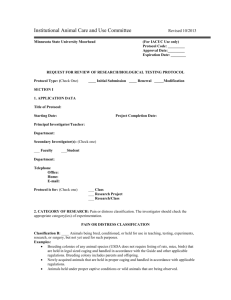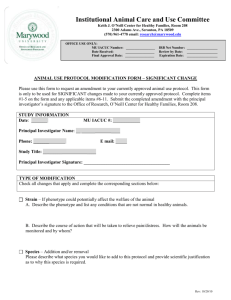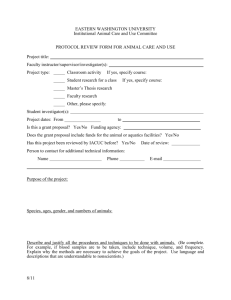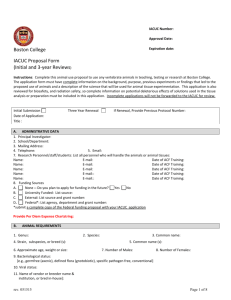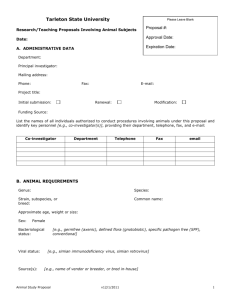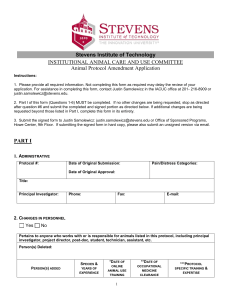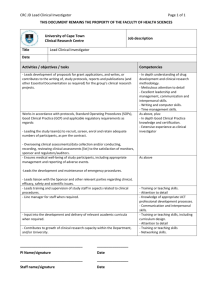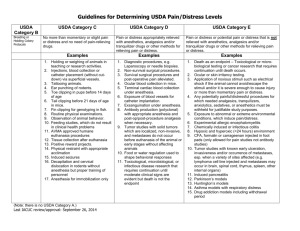Animal Use and Care
advertisement
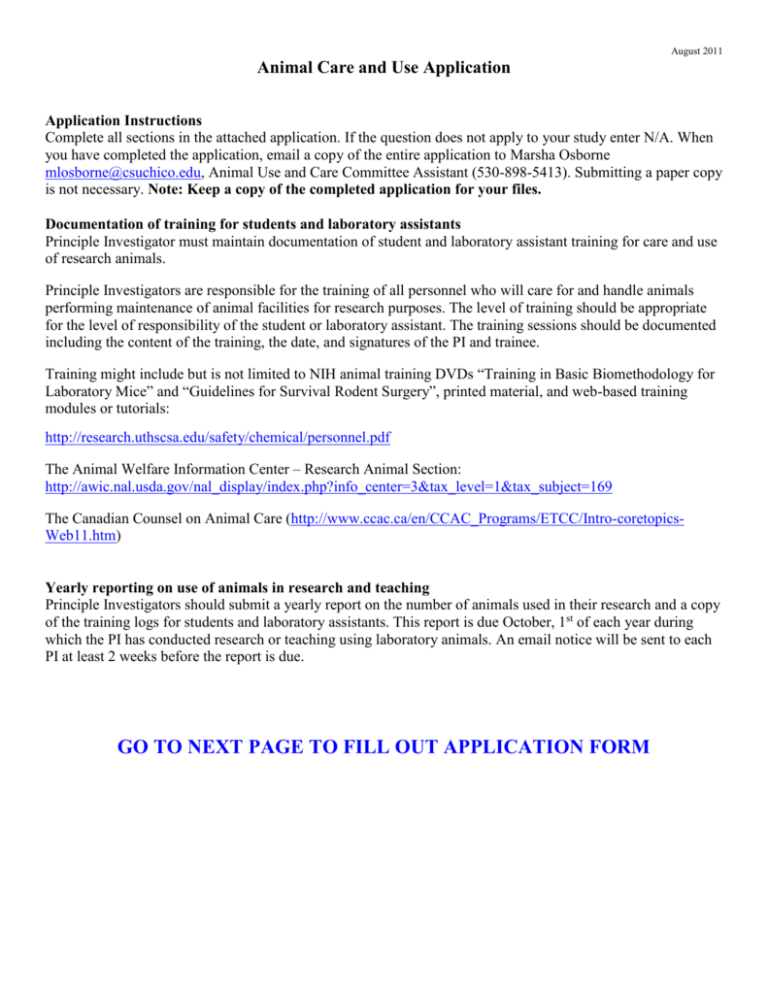
August 2011 Animal Care and Use Application Application Instructions Complete all sections in the attached application. If the question does not apply to your study enter N/A. When you have completed the application, email a copy of the entire application to Marsha Osborne mlosborne@csuchico.edu, Animal Use and Care Committee Assistant (530-898-5413). Submitting a paper copy is not necessary. Note: Keep a copy of the completed application for your files. Documentation of training for students and laboratory assistants Principle Investigator must maintain documentation of student and laboratory assistant training for care and use of research animals. Principle Investigators are responsible for the training of all personnel who will care for and handle animals performing maintenance of animal facilities for research purposes. The level of training should be appropriate for the level of responsibility of the student or laboratory assistant. The training sessions should be documented including the content of the training, the date, and signatures of the PI and trainee. Training might include but is not limited to NIH animal training DVDs “Training in Basic Biomethodology for Laboratory Mice” and “Guidelines for Survival Rodent Surgery”, printed material, and web-based training modules or tutorials: http://research.uthscsa.edu/safety/chemical/personnel.pdf The Animal Welfare Information Center – Research Animal Section: http://awic.nal.usda.gov/nal_display/index.php?info_center=3&tax_level=1&tax_subject=169 The Canadian Counsel on Animal Care (http://www.ccac.ca/en/CCAC_Programs/ETCC/Intro-coretopicsWeb11.htm) Yearly reporting on use of animals in research and teaching Principle Investigators should submit a yearly report on the number of animals used in their research and a copy of the training logs for students and laboratory assistants. This report is due October, 1st of each year during which the PI has conducted research or teaching using laboratory animals. An email notice will be sent to each PI at least 2 weeks before the report is due. GO TO NEXT PAGE TO FILL OUT APPLICATION FORM Animal Study Proposal Cover Sheet Primary Investigator: Select a, b or c: If a. is selected: Faculty Adviser Empl ID# a. Undergraduate: b. If b. is selected: Graduate Coordinator If c. is selected: Application is required for a grant or proposal? Yes If Yes—Name of Funding Source: Graduate c. Faculty Thesis Chair No College/Department of Primary Investigator: College / Dept Home Address of Primary Investigator: Street Address or P.O. Box State City Home Phone: Work Phone: Zip Email: Secondary Investigator: (Faculty Adviser or Theses Chair required to be Secondary Investigator if student is Primary Investigator) College / Dept Project Title: Project’s: Beginning Date Begin date can’t precede approval Select one: New Project Ending Date mm/dd/yy Modification mm/dd/yy Substudy If Modification or Substudy, please list project title and name of primary investigator from previous study. ANIMAL STUDY PROPOSAL Leave Blank Proposal #: Approval Date: PLEASE TYPE Expiration Date: A ADMINISTRATIVE DATA Department: Principal Investigator: Mailing Address: Telephone: Fax: Email: Project Title: Initial Submission Renewal or Modification List the names of all individuals authorized to conduct procedures involving animals under this proposal and identify key personnel (e.g., co-investigator(s), providing their department, telephone, fax, and email: Funding Source: A. ANIMAL REQUIREMENTS Genus: [e.g., Mus] Species: [e.g., C57BL] Strain, subspecies, or breed: Common name: [e.g., black laboratory mouse] Approximate age, weight or size: [e.g., musculus] EXPIRATION DATE: Sex: Bacteriological status: Viral status: Source(s): [e.g., germfree (axenic), defined flora (gnotobiotic), specific pathogen free, conventional] [e.g., simian immunodeficency virus, simian retrovirus] [e.g., name of vendor or breeder, bred in-house] Primary housing location(s): [Facility manager must certify below that facility has the resource capability to support the study. If animals will be housed in lab or anywhere else outside central facility for more than 12 hours, provide building and room number.] Location(s) where manipulation will be conducted: Number of Animals to be Used: Year 1: Total: Year 2: Year 3: B. TRANSPORTATION Transportation of animals must conform to all institutional guidelines/policies and federal regulations. If animals will be transported on public roads or out of state, describe efforts to comply with USDA regulations. If animals will be transported between facilities, describe the methods and containment to be utilized. If animals will be transported within a facility, include the route and elevator(s) to be utilized. D. STUDY OBJECTIVES Briefly explain in language understandable to a layperson the aim of the study and why the study is important to human or animal health, the advancement of knowledge, or the good of society. E. RATIONALE FOR ANIMAL USE (Use additional sheets if necessary.) 1) Explain your rationale for animal use. [The rationale should include reasons why non-animal models cannot be used.] 2) Justify the appropriateness of the species selected. [The species selected should be the lowest possible on the phylogenetic scale.] 3) Justify the number of animals to be used. [The number of animals should be the minimum number required to obtain statistically valid results.] F. DESCRIPTION OF EXPERIMENTAL DESIGN AND ANIMAL PROCEDURES (Use additional sheets if necessary.) Briefly explain the experimental design and specify all animal procedures. This description should allow the IACUC to understand the experimental course of an animal from its entry into the experiment to the endpoint of the study. Specifically address the following: Experimental injections or inoculations (substances, e.g., infectious agents, adjuvants, etc.; dose, sites, volume, route, and schedules). Blood withdrawals (volume, frequency, withdrawal sites, and methodology). Surgical procedures (provide details of survival and non-survival surgical procedures in Section G.). Radiation (dosage and schedule). Methods of restraint (e.g., restraint chairs, collars, vests, harnesses, slings, etc.). Include how animals are restrained for routine procedures like blood withdrawals. Prolonged restraint must be justified with appropriate oversight to ensure it is minimally distressing. Describe any sedation, acclimation or training to be utilized. Animal identification methods (e.g., ear tags, tattoos, collar, cage card, implant, etc.). Other procedures (e.g., survival studies, tail biopsies, etc.). Resultant effects, if any, that the animals are expected to experience (e.g., pain or distress, ascites production, etc.). Other potential stressors (e.g., food or water deprivation, noxious stimuli, environmental stress) and procedures to monitor and minimize distress. If a study is USDA Classification E, indicate any nonpharmaceutical methods to minimize pain and distress. Experimental endpoint criteria (e.g., tumor size, percentage body weight gain or loss, inability to eat or drink, behavioral abnormalities, clinical symptomatology, or signs of toxicity) must be specified when the administration of tumor cells, biologics, infectious agents, radiation or toxic chemicals are expected to cause significant symptomatology or are potentially lethal. List the criteria to be used to determine when euthanasia is to be performed. Death as an endpoint must always be scientifically justified. Veterinary care (indicate desired plan of action in case of animal illness, e.g., initiate treatment, call investigator prior to initiating treatment, euthanize). G. SURGERY If proposed, complete the following: (Use additional sheets if necessary.) 1. Identify and describe the surgical procedure(s) to be performed. Include preoperative procedures (e.g., fasting, analgesic loading), and monitoring and supportive care during surgery. Include the aseptic methods to be utilized. 2. Who will perform surgery and what are their qualifications and/or experience? 3. Where will surgery be performed and postoperative care provided (building and rooms)? 4. If survival surgery, describe postoperative care required, frequency of observation, and identify the responsible individual(s). Include detection and management of postoperative complications during work hours, after hours, weekends and holidays. 5. If non-survival surgery, describe how humane euthanasia is enacted and how death is determined. 6. Are paralytic agents used during surgery? If yes, please describe how ventilation will be maintained and how pain will be assessed. 7. Has major survival surgery been performed on any animal prior to being placed on this study? [Major survival surgery penetrates and exposes a body cavity or produces substantial impairment of physical or physiologic functions (such as laparotomy, thoracotomy, crainotomy, joint replacement, or limb amputation).] If yes, please explain: 8. Will more than one major survival surgery be performed on an animal while on this study? If yes, please justify: H. PAIN OR DISTRESS CLASSIFICATION AND CONSIDERATION OF ALTERNATIVES 1. Pain or Distress Classification Species (common name) USDA Classification* B, C, D or E Number of animals used each year Year 1 Year 2 Year 3 3 year total number of animals Total number of animals (should equal total from Section B): * USDA Classifications and Examples Classification B: Animals being bred, conditioned, or held for use in teaching, testing, experiments, research, or surgery, but not yet used for such purposes. Examples: Breeding colonies of any animal species (USDA does not require listing of rats, mice, birds) that are held in legal sized caging and handled in accordance with the Guide and other applicable regulations. Breeding colony includes parents and offspring. Newly acquired animals that are held in proper caging and handled in accordance with applicable regulations. Animals held under proper captive conditions or wild animals that are being observed. Classification C: Animals upon which teaching, research, experiments, or tests will be conducted involving no pain, distress, or use of pain-relieving drugs. Examples: Procedures performed correctly by trained personnel such as the administration of electrolytes/fluids, administration of oral medication, blood collection from a common peripheral vein per standard veterinary practice (dog cephalic, cat jugular) or catheterization of same, standard radiography, parenteral injections of non-irritating substances. Euthanasia performed in accordance with the recommendations of the most recent AVMA Panel on Euthanasia, utilizing procedures that produce rapid unconsciousness and subsequent humane death. Manual restraint that is no longer than would be required for a simple exam; short period of chair restraint for an adapted nonhuman primate. Classification D: Animals upon which experiments, teaching, research, surgery, or tests will be conducted involving accompanying pain or distress to the animals and for which appropriate anesthetic, analgesic, or tranquilizing drugs will be used. Examples: Surgical procedures conducted by trained personnel in accordance with standard veterinary practice such as biopsies, gonadectomy, exposure of blood vessels, chronic catheter implantation, laparotomy or laparoscopy. Blood collection by more invasive routes such as intracardiac or periorbital collection from species without a true orbital sinus such as rats and guinea pigs. Administration of drugs, chemicals, toxins, or organisms that would be expected to produce pain or distress but which will be alleviated by analgesics. Classification E: Animals upon which teaching, experiments, research, surgery, or tests will be conducted involving accompanying pain or distress to the animals and for which the use of appropriate anesthetic, analgesic, or tranquilizing drugs will adversely affect the procedures, results, or interpretation of the teaching, research, experiments, surgery, or tests. Examples: Procedures producing pain or distress unrelieved by analgesics such as toxicity studies, microbial virulence testing, radiation sickness, and research on stress, shock, or pain. Surgical and postsurgical sequella from invasion of body cavities, orthopedic procedures, dentistry or other hard or soft tissue damage that produces unrelieved pain or distress. Negative conditioning via electric shocks that would cause pain in humans. Chairing of nonhuman primates not conditioned to the procedure for the time period used. An explanation of the procedures producing pain or distress in these animals and the justification for not using appropriate anesthetic, analgesic or tranquilizing drugs must be provided on Attachment 1. This information is required to be reported to the USDA, will be available from USDA under the Freedom of Information Act, and may be publicly available through the Internet via USDA’s website. NOTE REGARDING CLASSIFICATION E: 2. Consideration of Alternatives If any procedures fall into USDA's Classification D or E, causing more than momentary or slight pain or distress to the animals, describe your consideration of alternatives and your determination that alternatives are not available. Delineate the methods and sources used in the search. Database references must include databases searched, the date of the search, period covered, and the keywords used. Alternatives include methods that (1) refine existing tests by minimizing animal distress, (2) reduce the number of animals necessary for an experiment, or (3) replace whole-animal use with in vitro or other tests. When ascites production is used to produce antibodies, justification needs to be given as to why in vitro systems cannot be used. Note that you must certify in Section Q.5. that no valid alternative was identified to any described procedures which may cause more than momentary pain or distress, whether relieved or not. I. ANESTHESIA, ANALGESIA, TRANQUILIZATION, OTHER AGENTS For animals indicated in Section H.1., Classification D, specify the anesthetics, analgesics, sedatives or tranquilizers that are to be used. Include the name of the agent(s), the dosage, route and schedule of administration. If information is provided in Section G. above, please cross-reference. Describe tracking and security of controlled drugs (Drug Enforcement Agency requirements). J. METHOD OF EUTHANASIA OR DISPOSITION OF ANIMALS AT END OF STUDY Indicate the proposed method of euthanasia. If a chemical agent is used specify the dosage and route of administration. If the method(s) of euthanasia include those not recommended by the AVMA Panel Report on Euthanasia (e.g., decapitation or cervical dislocation without anesthesia), provide scientific justification why such methods must be used. Indicate the method of carcass disposal if not described in Section K. below. K. HAZARDOUS AGENTS Use of hazardous agents requires the approval of the institutional Biosafety Office/Committee. Attach documentation of approval for the use of recombinant DNA or potential human pathogens. Hazardous Agent Yes No Agent Date of Biosafety Approval Tracking # Radionuclides Biological Agents Hazardous Chemicals or Drugs Recombinant DNA Study Conducted at Animal Biosafety Level: 1 2 3 4 Describe the practices and procedures required for the safe handling and disposal of contaminated animals and material associated with this study. Also describe methods for removal of radioactive waste and, if applicable, the monitoring of radioactivity. Additional safety considerations: L. BIOLOGICAL MATERIAL/ANIMAL PRODUCTS FOR USE IN ANIMALS (e.g., cell lines, antiserum, etc.) 1. Specify Material: 2. Source: Material Sterile or Attenuated: Yes No If derived from rodents, has the material been MAP/RAP/HAP tested? [MAP - Mouse Antibody Production; RAP Rat Antibody Production; HAP - Hamster Antibody Production] Yes 3. (Attach copy of results) or No I certify that the MAP/RAP/HAP tested materials to be used have not been passed through rodent species outside of the animal facility in question and/or the material is derived from the original MAP tested sample. To the best of my knowledge the material remains uncontaminated with rodent pathogens. Initials of Principal Investigator. M. TRANSGENIC AND KNOCKOUT ANIMALS Describe any phenotypic consequences of the genetic manipulations to the animals. Describe any special care or monitoring that the animals will require. N. EXEMPTIONS FROM ENVIRONMENTAL ENHANCEMENT FOR NONHUMAN PRIMATES OR EXERCISE FOR DOGS 1. For nonhuman primates, are you seeking an exemption for scientific reasons from the institution’s plan for environment enhancement? Yes or No If yes, provide the basis of the request. 2. For dogs, are you seeking an exemption for scientific reasons from the institution’s plan to provide dogs with the opportunity for exercise? Yes or No If yes, provide the basis of the request. O. FIELD STUDIES If animals in the wild will be used, describe how they will be observed, any interactions with the animals, whether the animals will be disturbed or affected, and any special procedures anticipated. Indicate if Federal permits are required and whether they have been obtained. P. SPECIAL CONCERNS OR REQUIREMENTS OF THE STUDY List any special housing, equipment, animal care (e.g., special caging, water, feed, or waste disposal, environmental enhancement, etc.). Q. PRINCIPAL INVESTIGATOR CERTIFICATIONS 1. I certify that I have attended the institutionally required investigator training course. Year of Course Attendance: Location: 2. I certify that I have determined that the research proposed herein is not unnecessarily duplicative of previously reported research. 3. I certify that all individuals working on this proposal who are at risk are participating in the Institution's Occupational Health and Safety Program. 4. I certify that the individuals listed in Section A. are authorized to conduct procedures involving animals under this proposal, have attended the institutionally required investigator training course, and received training in: the biology, handling, and care of this species; aseptic surgical methods and techniques (if necessary); the concept, availability, and use of research or testing methods that limit the use of animals or minimize distress; the proper use of anesthetics, analgesics, and tranquilizers (if necessary); and procedures for reporting animal welfare concerns. 5. For all USDA Classification D and E proposals (see section H.1.): I certify that I have reviewed the pertinent scientific literature and the sources and/or databases as noted in Section H.2. and have found no valid alternative to any procedures described herein which may cause more than momentary pain or distress, whether it is relieved or not. 6. I certify that I will obtain approval from the IACUC before initiating any significant changes in this study. 7. I certify that I will notify the IACUC regarding any unexpected study results that impact the animals. Any unanticipated pain or distress, morbidity or mortality will be reported to the attending veterinarian and the IACUC. 8. I certify that I am familiar with and will comply with all pertinent institutional, state, and federal rules and policies. Principal Investigator: Name: Signature: Date: R. CONCURRENCES PROPOSAL NUMBER _____________ (leave blank) Supervisory concurrence as applicable: Name: Signature: Date: Safety Office/Committee Certification of Review and Concurrence: (Required of all studies utilizing hazardous agents.) Name: Signature: Date: Facility Manager/Veterinarian certification of resource capability in the indicated facility to support the proposed study: Facility: Name: Signature: Date: Facility: Name: Signature: Date: Comments: Attending Veterinarian certification of review and consultation on proper use of anesthetics and pain relieving medications for any painful procedures: Name: Signature: Date: S. FINAL APPROVAL: Certification of review and approval by the Institutional Animal Care and Use Committee: Name: List any attachments here: Signature: Date: Attachment 1 Explanation for USDA Classification E (This report is required to accompany USDA Form 7023 to support any USDA Classification E listings.) This document must be typed. Name of investigator: Animal Study Proposal Title: Species and number of animals listed in Classification E for each year: Species: Number of animals: year 1 year 2 year 3 Total: Description of project including reason(s) for species selection: Provide a scientific justification to explain why the use of anesthetics, analgesics, sedatives or tranquilizers during and/or following painful or distressing procedures is contraindicated: Signature of investigator: Date: Signature of IACUC Chairperson: Date:
